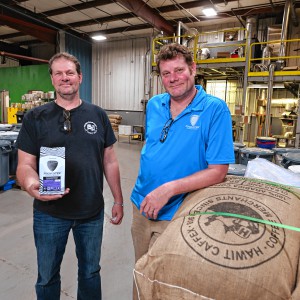Rare frosted elfin caterpillar spotted in Montague wildlife area
| Published: 07-18-2023 5:00 PM |
MONTAGUE — Anywhere from 100 to 10,000 species go extinct each year, a rate 100 to 1,000 times faster than historic extinction rates, according to the American Museum of Natural History. Other species see their habitats condensed by urban development, deforestation and other human impacts.
Sometimes, though, there’s good news.
The Massachusetts Division of Fisheries and Wildlife announced this month that the rare frosted elfin caterpillar has been observed in the Montague Plains Wildlife Management Area. The frosted elfin, designated as a “species of special concern” in Massachusetts, is only found at about two dozen sites across the state. According to MassWildlife, the discovery can be credited to two decades worth of restoration and maintenance of the pine barrens habitat through prescribed fire, tree cutting and mowing.
“The unique barrens habitat at Montague Plains [Wildlife Management Area] is considered regionally and globally rare, making our restoration efforts at this site especially important for rare animals and plants that require this special habitat type,” Brian Hawthorne, MassWildlife’s habitat program manager, said in the announcement. “It is incredibly rewarding to see decades of effort paying off.”
The discovery “pleasantly surprised” Mark Fairbrother, a Montague resident and amateur naturalist. He explained that the species had been observed in Montague before at the Turners Falls Municipal Airport, but not “for a number of years” due to public access becoming more restricted.
“It used to be that out there, you could pick blueberries and walk your dog,” he said. “It’s a lot more strict out there nowadays.”
The Montague Plains area, which MassWildlife identified as the largest inland pine barrens habitat in Massachusetts, is a sensible location to find the frosted elfin caterpillar, Fairbrother added.
He explained that the habitat is an “outwash plain” and a remnant of Glacial Lake Hitchcock, the massive body of water that occupied what is now the Connecticut River Valley thousands of years ago. The habitat is characterized by MassWildlife as having “an open tree canopy and lots of shrubby undergrowth,” and “deep, coarse glacial sands” that give rise to the area’s “unique features and the specialized plants and animals that live there.”
Article continues after...
Yesterday's Most Read Articles
 1989 homicide victim found in Warwick ID’d through genetic testing, but some mysteries remain
1989 homicide victim found in Warwick ID’d through genetic testing, but some mysteries remain
 Fogbuster Coffee Works, formerly Pierce Brothers, celebrating 30 years in business
Fogbuster Coffee Works, formerly Pierce Brothers, celebrating 30 years in business
 Greenfield homicide victim to be memorialized in Pittsfield
Greenfield homicide victim to be memorialized in Pittsfield
 Real Estate Transactions: May 3, 2024
Real Estate Transactions: May 3, 2024
 Battery storage bylaw passes in Wendell
Battery storage bylaw passes in Wendell
 As I See It: Between Israel and Palestine: Which side should we be on, and why?
As I See It: Between Israel and Palestine: Which side should we be on, and why?
“It has extremely good drainage because there’s so much sand there and water drains quickly,” Fairbrother described, adding that the habitat is “kind of the opposite of wetlands.”
“The plants that are going to be living there — and the creatures that eat the plants — have to be adapted to low water and a high-soil habitat.”
According to MassWildlife, efforts to preserve the habitat have included promoting the growth of lupine and wild indigo in an effort to maintain “the open habitat needed by both the frosted elfin and its food plants.” According to Assistant Town Administrator Walter Ramsey, maintenance of the Montague Plains has involved keeping portions of the land flat and guarded by “doughnuts” of bordering trees that serve as barriers.
Surveys have shown that habitat restoration efforts are working, MassWildlife stressed. These efforts have yielded an abundance of barrens plants including wild lupine, New Jersey tea, scrub oak and low-bush blueberry. Uncommon and rare moths, butterflies, native bees, the eastern hognose snake, the eastern box turtle, the whip-poor-will, the eastern towhee, the prairie warbler, the American woodcock and the ruffed grouse are among the animals benefiting from these efforts. The number of rare species that exist in the Montague Plains is “more than normal,” said Sean Werle, a longtime Montague resident, aquatic biologist and entomologist.
“I think ecosystems work by having all of their parts intact,” Werle expressed. “Any time we can repair something that’s broken and doesn’t allow all these species to thrive, of course we should fix it.”
“Everything that’s there got there over a long period of time, has adapted to be there and has a right to be there,” Fairbrother added. “It should not be thrown into eternity for pretty short-term reasons.”
Reach Julian Mendoza at 413-930-4231 or jmendoza@recorder.com.

 Bridge of Flowers in Shelburne Falls to open on plant sale day, May 11
Bridge of Flowers in Shelburne Falls to open on plant sale day, May 11 Community Legal Aid expands Disability Benefits Project to Franklin County
Community Legal Aid expands Disability Benefits Project to Franklin County Wear Orange organizers prepare display to remember gun violence victims
Wear Orange organizers prepare display to remember gun violence victims Deerfield candidates, Whately incumbent discuss issues with voters at South County Senior Center
Deerfield candidates, Whately incumbent discuss issues with voters at South County Senior Center
